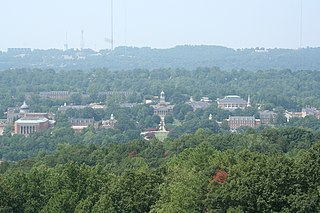
Homewood is a city in southeastern Jefferson County, Alabama, United States. It is a suburb of Birmingham, located on the other side of Red Mountain due south of the city center. As of the 2010 census its population was 25,167, and in 2019 the estimated population was 25,377.

This is a list of properties and historic districts in Missouri on the National Register of Historic Places. There are NRHP listings in all of Missouri's 114 counties and the one independent city of St. Louis.

The Missouri State Fair is the state fair for the state of Missouri, which has operated since 1901 in Sedalia, Missouri. It includes daily concerts, exhibits and competitions of animals, homemade crafts, shows, and many food/lemonade stands, and it only lasts 11 days. Its most famous event is the mule show, which has run since its inception. The fairgrounds are located at 2503 W 16th Street on the southwest side of the city at the intersection of West 16th Street and South Limit Avenue.
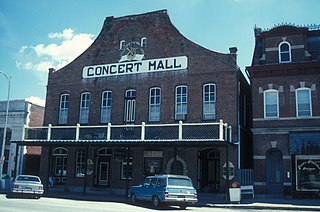
Hermann Historic District is a national historic district located at Hermann, Gasconade County, Missouri. The district encompasses 360 contributing buildings, 4 contributing structures, and 3 contributing objects in the central business district and surrounding residential sections of Hermann. The district developed between about 1838 and 1910, and includes representative examples of Greek Revival and Classical Revival style architecture. Notable buildings include the Eitzen House (1855), Potnmer-Gentner House (1848), Hermann City Hall (1906), Strehly House (1845), Concert Hall (1877), The German School (1871), and Gasconade County Courthouse (1896).

The St. Charles Historic District is a national historic district located at St. Charles, St. Charles County, Missouri. It is the site of the first permanent European settlement on the Missouri River and of the embarkation of Lewis and Clark's journey of exploration along the Missouri. The first state capital of Missouri and over one hundred other historic buildings are located in the district.
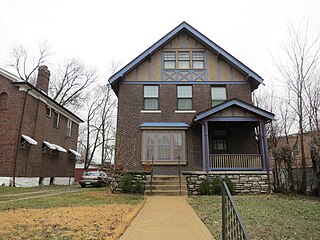
The Hamilton Place Historic District is a 43-acre (17 ha) historic district in St. Louis, Missouri that was listed on the National Register of Historic Places in 2005. It includes 160 contributing buildings, including along the 5900-6000 blocks of Enright, Cates, and Clemens. It includes Late Victorian architecture and Late 19th and 20th Century Revivals architecture, and it includes work by architects Barnett, Haynes & Barnett.

Martha Jefferson Historic District, also known as Locust Grove Addition, is a national historic district located at Charlottesville, Virginia. The district encompasses 154 contributing buildings, 1 contributing site, and 1 contributing structure in a primarily residential section of the city of Charlottesville. It was developed between 1893 and 1957 and includes examples of the Late Victorian and Colonial Revival styles. Notable buildings include the Eddins-Tilden House (1901), Dorothy S. Marshall House (1941), and Martha Jefferson Hospital (1928-1929). Located in the district is the separately listed Locust Grove.

The Downtown Commercial Historic District encompasses most of the central business district of Burlington, Iowa, United States. It was listed on the National Register of Historic Places in 2015. The historic district includes 65 properties that were part of a 2012 to 2013 survey of the area. It also includes as contributing properties the buildings in the West Jefferson Street Historic District and three buildings in the Manufacturing and Wholesale Historic District that were previously listed on the National Register. All total there are 122 resources within the district, which includes 108 contributing and 14 non-contributing properties.

Jefferson Street Historic District is a national historic district located at Gary, Indiana. The district encompasses 81 contributing buildings in an exclusively residential section of Gary. They were largely built between 1922 and 1945, and many reflect the American Small House Movement. Architectural styles include examples of Colonial Revival, Tudor Revival, Late Gothic Revival, Spanish Colonial Revival, and Bungalow / American Craftsman architecture.
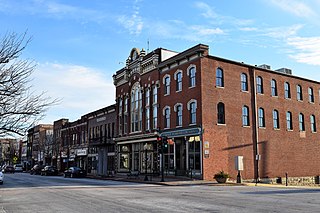
Missouri State Capitol Historic District is a national historic district located at Jefferson City, Cole County, Missouri. It encompasses 122 contributing buildings in the central business district of Jefferson City. The district developed between about 1850 and 1950, and includes representative examples of Classical Revival, Late Victorian, Queen Anne, Mission Revival, and Modern Movement style architecture. Located in the district are the separately listed Missouri State Capitol, Lohman's Landing Building, Cole County Historical Society Building, Cole County Courthouse and Jail-Sheriff's House, Missouri Governor's Mansion, and Tergin Apartment Building. Other notable buildings include the St. Peter's Roman Catholic Church complex (1881-1883), Margaret Upshulte House, Broadway State Office Building (1938), Supreme Court of Missouri (1905-1906), U.S. Post Office and Courthouse (1932-1934), Lohman's Opera House, Missouri State Optical, First United Methodist Church (1900), Carnegie Public Library (1901), Temple Beth El (1883), and Joseph and Susie Kolkmeyer House.
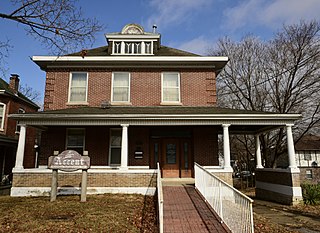
Broadway–Dunklin Historic District is a national historic district located in Jefferson City, Cole County, Missouri. It encompasses 23 contributing buildings in a predominantly residential section of Jefferson City. The district developed between about 1885 and 1915, and includes representative examples of Classical Revival, Late Victorian, and Colonial Revival style architecture. Notable buildings include the former Broadway School (1904).

Capitol Avenue Historic District is a national historic district located at Jefferson City, Cole County, Missouri. It encompasses 107 contributing buildings in a predominantly residential section of Jefferson City. The district developed between about 1870 and 1947, and includes representative examples of Classical Revival, Late Victorian, Bungalow / American Craftsman, and Art Deco style architecture. Located in the district are the separately listed Lester S. and Missouri "Zue" Gordon Parker House, Jefferson Female Seminary, Missouri State Penitentiary Warden's House, and Ivy Terrace. Other notable buildings include the Parsons House (1830), former Missouri Baptist Building (1947), Grace Episcopal Church (1898), Elizabeth Alien Ewing House (1873), James A. Houchin House, J. Henry Asel, Sr. and Hilda Asel House (1898), Dix Apartments (1915), W.C. Young House, Bella Vista Apartments (1928), and Prince Edward Apartments (1930).

Moreau Park Historic District is a national historic district located near Jefferson City, Cole County, Missouri. It encompasses seven contributing buildings, one contributing site, and five contributing structures associated with a former resort along the Moreau River near Jefferson City. The district developed between about 1914 and 1950, and includes some historic landscaping features, the native stone Dallmeyer House, Moreau Lodge (1914), one remaining guest cabin, two stone outbuildings, a privy, barn, and concession stand.
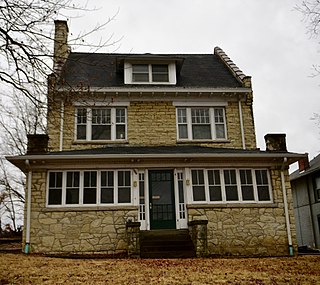
Hobo Hill Historic District is a national historic district located in Jefferson City, Cole County, Missouri. It encompasses seven contributing buildings in a predominantly residential section of Jefferson City. The district developed between about 1908 and 1916, and includes representative examples of Tudor Revival, Colonial Revival, Bungalow / American Craftsman, and American Foursquare style architecture. Notable buildings include the Adolph Brandenberger House (1910).

Gustave Greystone-Meissner House, also known as Greystone and Evergreen Hill, is a historic home and national historic district located near Pevely, Jefferson County, Missouri. Greystone was built about 1845, and is a two-story, asymmetrical plan, Gothic Revival style frame dwelling. It sits on a limestone block foundation and measures 48 feet, 1 1/2 inches, wide and 39 feet, 1 inch deep. It has a steeply pitched gable roof with dormers and features Carpenter Gothic wood cut-work, finials and drops. Also on the property is the contributing Gustave Meissner House. It was built in 1875, and is 1 1/2-story, "L"-shaped, frame dwelling with a steeply pitched cross-gable roof.

Midtown Neighborhood Historic District is a national historic district located at St. Charles, St. Charles County, Missouri. The district encompasses 527 contributing buildings, 7 contributing sites, and 5 contributing objects in a predominantly residential section of St. Charles. It developed between about 1838 and 1959, and includes representative examples of Federal, Greek Revival, Gothic Revival, Italianate, Queen Anne, Romanesque Revival, Folk Victorian, Colonial Revival, Classical Revival, Tudor Revival, and Bungalow / American Craftsman style architecture. Located in the district are the separately listed African Church and Oliver L. and Catherine Link House. Other notable buildings include the St. Charles County Courthouse, Benton School (1896), St. John's A.M.E. Church (1872), Immanuel Lutheran Church (1867), Jefferson Street Presbyterian Church, Fourth Street Market Grocery (1926-1927), West End Grocery and Meat Market, Dr. Ludwell Powell House (1838), Rogers-Ehrhard House, Waye Monument Company and Residence (1889), Meyer House, Kaemmerlen House, and Elsner House.

The Jefferson Street Historic District is a nationally recognized historic district located in Iowa City, Iowa, United States. It was listed on the National Register of Historic Places in 2004. At the time of its nomination it consisted of 39 resources, which included 36 contributing buildings and three non-contributing buildings. This section of the city started to develop to its present form in the late 19th and early 20th centuries. During this period the neighborhood was transformed from residential to include churches and buildings associated with the University of Iowa and its hospitals. Both professionals and business owners lived here, along with working-class people. Graduate students, especially those associated with the medical professions, resided in apartment buildings here. Four architecturally significant churches, along with their attendant buildings, are located in the district.
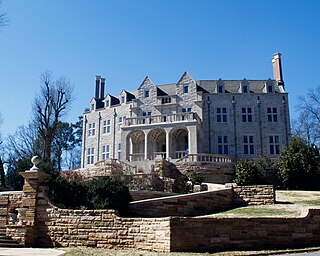
The Red Mountain Suburbs Historic District, in Jefferson County, Alabama, including parts of Birmingham and Mountain Brook, is a 333 acres (135 ha) historic district which was listed on the National Register of Historic Places in 1985. The listing included 392 contributing buildings and three contributing structures.

Washington–Jefferson Street Historic District in Clarkesville, Georgia is a 23 acres (9.3 ha) mostly residential historic district. It was listed on the National Register of Historic Places in 1982 and includes 13 contributing buildings and a contributing site.

The Whitehall Street Retail Historic District is a historic district in Atlanta, Georgia, United States. The district is centered on Peachtree Street and Martin Luther King Jr. Drive and includes Broad, Forsyth, and Mitchell Streets. It was added to the National Register of Historic Places in 2020.
























